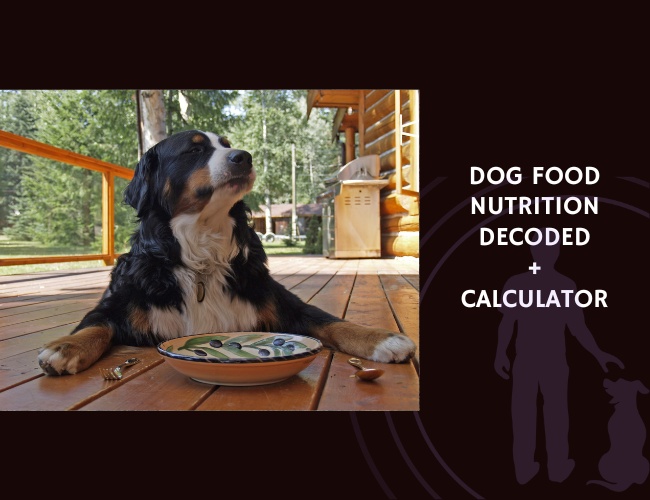Understanding Basic Nutritional Requirements
Key Macronutrients and Their Roles in Dog Health
Dogs, like humans, need a variety of macronutrients to maintain their health. Understanding the roles of proteins, fats, and carbohydrates in their diet is crucial for ensuring their well-being.
- Proteins: Proteins are the building blocks of your dog’s body. They support the development and maintenance of muscles, repair tissues, and create enzymes and hormones. Quality protein sources include meat, fish, eggs, and legumes.
- Fats: Fats are essential for energy, supporting cell structure, and aiding the absorption of fat-soluble vitamins. Essential fatty acids, like Omega-3 and Omega-6, are vital for a healthy coat and skin. Common sources of fats in dog food are chicken fat, fish oil, and flaxseed oil.
- Carbohydrates: Carbohydrates provide energy and dietary fiber, which supports digestive health. While dogs don’t have a dietary requirement for carbohydrates, they are often included in dog foods to provide a balanced diet. Sources include whole grains like brown rice, barley, and vegetables.
AAFCO and FEDIAF Guidelines for Complete and Balanced Nutrition
When selecting dog food, it’s important to ensure it meets the standards set by the Association of American Feed Control Officials (AAFCO) and the European Food Safety Authority (FEDIAF). These organizations provide guidelines to ensure that pet food is nutritionally complete and balanced.
- AAFCO: AAFCO provides nutrient profiles that pet foods must meet to be marketed as “complete and balanced.” These profiles outline the minimum and maximum nutrient levels for different life stages, such as growth, reproduction, and adult maintenance.
- FEDIAF: Similar to AAFCO, FEDIAF sets nutritional guidelines for pet food sold in Europe to ensure it meets the dietary needs of pets at various life stages. FEDIAF guidelines also emphasize the importance of safety and quality control in pet food production.
Look for the AAFCO or FEDIAF statement on the dog food label to be confident that the diet you are choosing meets these established standards.
Importance of Age-Appropriate Nutritional Requirements
Just as humans have different nutritional requirements at various stages of life, dogs do too. Puppies, adults, and senior dogs have unique needs that must be met for optimal health.
- Puppies: Growing puppies need more protein and higher calorie content to support their rapid growth and development. Look for foods specifically formulated for puppies, often labeled as “growth” or “all life stages.”
- Adults: Adult dogs require a balance of nutrients to maintain their health and energy levels. Foods formulated for adult maintenance will provide the appropriate levels of protein, fat, and other nutrients to keep your adult dog healthy.
- Seniors: Older dogs may need fewer calories but higher levels of fiber to support digestive health. Senior formulas often include joint-supporting nutrients like glucosamine and chondroitin to help maintain mobility.
Ensuring your dog receives age-appropriate nutrition helps prevent health issues and supports overall well-being. Always consult with your veterinarian if you have concerns about your dog’s dietary needs or if you are considering a change in their diet.
By understanding the basics of dog nutrition and following established guidelines, you can make informed choices about your dog’s diet, promoting a long, healthy life.
Evaluating Commercial Dog Foods: Nutritional Adequacy and Safety
When it comes to evaluating dog food quality, understanding the nutritional adequacy and safety of commercial options is crucial for your pet’s health. The first step in assessing dog food quality is to examine the ingredient list. Look for high-quality protein sources such as chicken, beef, or fish listed at the top, as these indicate a significant presence of essential nutrients. Avoid vague terms like “meat meal” or “animal by-products,” which can suggest lower quality ingredients. Another key aspect is ensuring the food meets established nutritional standards. Check for an AAFCO (Association of American Feed Control Officials) statement on the packaging, which confirms that the food provides complete and balanced nutrition for your dog’s specific life stage. This certification ensures that the product has undergone rigorous testing and meets the minimum nutrient requirements necessary for maintaining your dog’s health. Safety is equally important when evaluating dog food. Opt for brands that adhere to strict quality control measures, such as batch numbers and expiration dates, which help trace products in case of recalls. Additionally, be wary of artificial additives and preservatives like BHA, BHT, and ethoxyquin, as these can be harmful over time. Instead, choose foods preserved with natural antioxidants like tocopherols (vitamin E) or ascorbic acid (vitamin C). By focusing on these factors, you can confidently select a dog food that supports your pet’s well-being and longevity.
When evaluating commercial dog foods for nutritional adequacy and safety, it’s crucial to consult established guidelines that ensure the food meets basic nutritional requirements. The Association of American Feed Control Officials (AAFCO) provides comprehensive nutrient profiles that pet foods must adhere to in order to be marketed as “complete and balanced.” These profiles outline the minimum and maximum nutrient levels necessary for different life stages, such as growth, reproduction, and adult maintenance. By checking for an AAFCO statement on the packaging, you can confirm that the food has undergone rigorous testing and meets these essential standards.

In addition to AAFCO, the European Pet Food Industry Federation (FEDIAF) offers similar guidelines for pet food sold in Europe. FEDIAF emphasizes not only the nutritional completeness but also the safety and quality control in pet food production. Foods that meet FEDIAF standards are formulated to provide a balanced diet that supports your dog’s health at various life stages. Ensuring that a commercial dog food aligns with either AAFCO or FEDIAF guidelines is a reliable way to verify its nutritional adequacy and safety.
For pet owners seeking to make informed decisions about their dog’s diet, understanding these guidelines is key. Both AAFCO and FEDIAF statements serve as indicators of a product’s nutritional integrity, helping you choose foods that support your dog’s well-being.
Always look for these certifications on dog food labels to ensure you’re providing a diet that meets your pet’s specific needs.
Protein Content Analysis
Proteins play an essential role in your dog’s health, supporting muscle development, tissue repair, hormone production, and a variety of other functions. Let’s dive into how to assess protein content to ensure your dog’s diet is meeting their needs.
How to Identify Quality Protein Sources on Ingredient Labels
When you look at the ingredient list on your dog’s food, finding quality protein sources is critical. High-quality proteins generally come from animal sources, such as:
- Meat (e.g., chicken, beef, lamb)
- Fish (e.g., salmon, whitefish)
- Eggs
- Organ meats (e.g., liver, kidney)
Ingredients listing specific meats, such as “chicken” or “beef,” are preferable to vague terms like “meat meal” or “animal by-products,” as these can be of lower quality. Also, ingredients listed early on the label tend to be present in larger amounts, indicating a higher proportion of protein.
Understanding Crude Protein vs. Digestible Protein
Protein quality isn’t solely about the amount listed; you also need to understand the terms “crude protein” and “digestible protein.”
- Crude protein is a measurement of the total protein content in the food, including both digestible and indigestible components. It’s a standard measure but doesn’t reflect the protein’s actual usability.
- Digestible protein measures the proportion of protein that can be absorbed and used by your dog’s body. This is a better indicator of the true nutritional value of a protein source.
Manufacturers might not always provide digestible protein information directly on labels, but you can infer quality from the presence of high-quality, recognizable ingredients.
Recommended Protein Levels for Different Life Stages
Protein needs vary by life stage, reflecting different physiological requirements.
- Puppies: Growing puppies need higher protein levels to support rapid growth and development. Typically, a diet with at least 22% protein content, on a dry matter basis, is recommended.
- Adult Dogs: Maintenance diets for adult dogs should provide around 18% protein content to sustain muscle mass and overall health.
- Senior Dogs: Older dogs might benefit from slightly higher protein levels, around 20-25%, but adjusted to lower calorie levels to prevent weight gain. Higher protein can help them maintain muscle mass and support body functions.
Recognizing these requirements on the dog food label can guide you in choosing the right food for your dog’s current life stage.
With these insights, you can better evaluate protein sources in your dog’s diet, ensuring they get the necessary nutrition to thrive. In the next section, we’ll explore the significance of fats in your dog’s diet, how to assess fat content on labels, and how to balance their intake for optimal health. This comprehensive understanding will aid you in making informed choices about your dog’s nutrition.
Fat Content Evaluation
Essential Fatty Acids and Their Importance in Dog Nutrition
Fat is not just a source of energy for your dog; it plays a pivotal role in maintaining overall health and vitality. Essential fatty acids (EFAs) are a category of fats that are crucial for various physiological functions but cannot be synthesized by your dog’s body. This means they must be obtained through diet.
Two Important Types of EFAs:
- Omega-3 Fatty Acids: Common sources include fish oils, flaxseed, and canola oil. Omega-3 fatty acids are known for their anti-inflammatory properties and are vital for brain development, heart health, and shiny coats.
- Omega-6 Fatty Acids: These are typically found in chicken fat, sunflower oil, and safflower oil. They play a critical role in skin health, coat glossiness, and reproduction.
An appropriate balance between these fatty acids is essential. Too much or too little of either one can lead to health issues.
How to Interpret Fat Content Percentages on Labels
Reading and understanding the fat content on dog food labels is key to ensuring your dog gets the right amount of fat. Here’s how you can decode this information:
- Identify the Crude Fat Content: This is listed under the guaranteed analysis section of the label. Crude fat is the total fat content in the food. For example, a label may state “Crude Fat (Min): 12%.”
- Determine the Source of Fat: Quality of fat sources matters. Look for specific animal fats such as “chicken fat” or “salmon oil” rather than vague terms like “animal fat.”
- Assess the Fatty Acids: Higher-quality dog foods often list specific fatty acids under the crude fat percentage. Understanding the ratio of Omega-6 to Omega-3 fatty acids can provide insight into the dietary balance.
Balancing Fat Intake for Weight Management and Energy Needs
Ensuring your dog receives the correct amount of fat is crucial for maintaining a healthy weight and energy levels. Here’s how to balance fat intake based on your dog’s life stage and activity level:
- Puppies: They require a higher percentage of fat compared to adults due to their rapid growth and high energy needs. Aim for 8-10% fat content in their diet.
- Adult Dogs: A balanced fat intake helps maintain steady energy levels. Generally, an adult dog’s diet should include around 5% fat.
- Senior Dogs: As dogs age, their metabolism slows down. Senior dogs typically need less fat, around 6-8%, to avoid unnecessary weight gain while still receiving enough for essential bodily functions.
- Active and Working Dogs: Dogs that are highly active or working have increased energy requirements and can benefit from a higher fat content to fuel their stamina and maintain muscle mass.
Remember, providing the right fat balance is a dynamic process that may need adjustments as your dog ages or its activity levels change. Always consult your veterinarian to tailor the fat content to your pet’s specific needs.
This careful attention to fat content not only ensures your dog stays energetic and healthy but also positions you to better understand other aspects of their nutritional requirements.
Vitamin and Mineral Assessment
Ensuring your dog’s diet is rich in essential vitamins and minerals is vital for their overall health and well-being. This chapter will guide you through the critical vitamins and minerals necessary for your dog’s health, recognizing the signs of deficiencies and excesses, and evaluating the micronutrient adequacy in dog food. Let’s explore these components to ensure your furry friend remains healthy and vibrant.
Critical Vitamins and Minerals for Dog Health
Dogs need a balanced intake of various vitamins and minerals for their body to function optimally. Here are some of the most critical ones:
- Vitamin A: Essential for vision, immune function, and skin health.
- Vitamin D: Important for bone development and calcium regulation.
- Vitamin E: An antioxidant that helps protect cells from damage and supports immune function.
- Vitamin K: Necessary for blood clotting and bone health.
- B Vitamins: (including B1, B2, B6, B12) Support energy metabolism, enzyme function, and red blood cell production.
- Calcium: Crucial for bone health, muscle function, and nerve transmission.
- Phosphorus: Works alongside calcium for strong bones and teeth.
- Potassium: Helps with muscle function and maintaining fluid balance.
- Magnesium: Involved in many biochemical reactions in the body, including energy production.
- Iron: Necessary for the production of hemoglobin, which carries oxygen in the blood.
Including these vitamins and minerals in the right proportions is essential for preventing deficiencies and promoting your dog’s health.

Signs of Vitamin Deficiencies and Excesses
Being aware of the signs of vitamin and mineral imbalances can help you address potential health issues early.
Deficiencies
- Vitamin A: Poor vision, especially in low light, and rough coat.
- Vitamin D: Weak bones, fractures, and difficulty walking.
- Vitamin E: Muscle weakness, poor vision, and reproductive issues.
- Vitamin K: Excessive bleeding and bruising.
- B Vitamins: Fatigue, poor coat, decreased appetite, and neurological issues.
- Calcium and Phosphorus: Weak bones and teeth, muscle tremors.
- Potassium: Weakness, lethargy, and heart irregularities.
- Magnesium: Muscle tremors, depression, and heart issues.
- Iron: Anemia, weakness, and pale gums.
Excesses
- Vitamin A: Bone abnormalities, lethargy, and weight loss.
- Vitamin D: Calcium deposits in soft tissues, kidney damage.
- Vitamin E: Rare, but can interfere with blood clotting.
- Vitamin K: Very rare, but excess synthetic forms can cause toxicity.
- Calcium: Skeletal abnormalities, kidney stones.
- Phosphorus: Kidney damage if paired with low calcium.
- Potassium: Rare in healthy dogs, but excess can affect heart function.
- Iron: Vomiting, diarrhea, and organ damage.
How to Evaluate Micronutrient Adequacy in Dog Food
When choosing a dog food, it’s essential to evaluate whether it provides all necessary vitamins and minerals. Here’s how you can do it:
- Check the Ingredient List: Quality dog foods will list a variety of ingredients that contribute to a balanced diet, such as meats, vegetables, and grains. Look for natural sources of vitamins and minerals.
- Look for AAFCO and FEDIAF Statements: Foods that meet the standards of the Association of American Feed Control Officials (AAFCO) or the European Pet Food Federation (FEDIAF) are formulated to provide complete and balanced nutrition.
- Analyze the Nutritional Guarantee: Ensure the nutritional guarantee on the label includes statements about the adequacy of vitamins and minerals.
- Consult Your Vet: If you have any doubts, consult your veterinarian to review your dog’s diet and make recommendations.
Proper assessment of your dog’s food will help ensure their nutritional needs are met, supporting their health and well-being.
With a solid understanding of vitamins and minerals, you’re now more equipped to make informed decisions about your dog’s diet. Continue investigating to maintain your dog’s overall well-being.
Reading and Understanding Labels
Understanding dog food labels can seem complex, but it’s crucial for ensuring your furry friend’s nutrition. Knowledge of ingredient lists, nutritional guarantees, quality control, and potential red flags in ingredient declarations will empower you to make the best choices for your dog’s health.
Decoding Ingredient Lists and Nutritional Guarantees
The ingredient list on dog food labels is where you’ll find all the components making up the food. Ingredients are listed in descending order by weight. This means the first few ingredients are the most significant in terms of volume.
Key Points to Look For:
- Whole Meats and Meals: Ingredients like “chicken,” “beef,” or “salmon” should appear near the top to ensure high-quality protein sources. “Chicken meal” or “beef meal” are also good as they indicate concentrated protein, but avoid generic terms like “meat meal” or “animal by-product,” which can be of lower quality.
- Named Fat Sources: Look for specific fats like “chicken fat” or “salmon oil,” which provide essential fatty acids beneficial for your dog’s coat and skin.
- Whole Vegetables and Grains: Ingredients such as sweet potatoes, brown rice, or carrots contribute essential vitamins and minerals. Avoid foods that list “corn” or “soy” as the primary ingredients, as these can be less nutritious fillers.
Nutritional guarantees typically follow the ingredients list, detailing the minimum percentages of crude protein and fat and the maximum percentages of crude fiber and moisture. The guarantees help ensure the food meets basic nutritional standards.
Identifying Quality Control Measures and Safety Standards
Safety and quality control are paramount when choosing dog food. Food must abide by guidelines set forth by authorities like the Association of American Feed Control Officials (AAFCO) in the United States and the European Pet Food Industry Federation (FEDIAF) in Europe. Foods meeting these standards will have statements such as “meets AAFCO nutritional requirements.”
Key Quality Indicators:
- Manufacturer’s Contact Information: A reputable company will provide clear contact details, including address and phone number, enabling you to inquire about sourcing and quality control.
- Batch Numbers: These help trace the product in case of recalls and indicate good manufacturing protocols.
- Expiration Dates: These ensure the product is fresh and safe for your dog.
Spotting Red Flags in Ingredient Declarations
Several red flags may indicate lower quality dog food. Being vigilant about these can prevent you from making less nutritious choices.
Common Red Flags:
- Unnamed Animal Products: Terms like “animal fat” or “meat by-products” lack specificity and may signal lower quality or mixed sources.
- Artificial Additives: Ingredients such as artificial colors, flavors, and preservatives (BHA, BHT, ethoxyquin) can be harmful over time. Opt for foods preserved with natural antioxidants like tocopherols (vitamin E) or ascorbic acid (vitamin C).
- Excessive Fillers: Ingredients like corn gluten meal, soybean meal, and wheat middlings serve as fillers and provide minimal nutritional value compared to whole grains and protein.
Understanding these aspects of dog food labels can significantly impact your dog’s health. By prioritizing transparent labeling, high-quality ingredients, and reputable manufacturers, you can better ensure your dog enjoys a long, healthy life.
Special Considerations and Trends
Alternative Protein Sources and Novel Ingredients
In recent years, dog food has seen a fascinating shift toward alternative protein sources and novel ingredients. These innovative options provide valuable nutrition while also accommodating dogs with specific dietary needs, allergies, or sensitivities. Let’s dive into some of these alternative protein sources and their benefits.
- Insect Proteins: Insects such as black soldier fly larvae, mealworms, and crickets offer a highly nutritious and environmentally friendly protein source. They are rich in essential amino acids, vitamins, and minerals. Moreover, insect farming has a lower ecological footprint compared to traditional livestock farming.
- Plant-Based Proteins: For dogs with animal protein sensitivities or for those on vegetarian or vegan diets, plant-based proteins like peas, lentils, and quinoa serve as excellent alternatives. They provide vital nutrients and can be beneficial for dogs with specific health conditions.
- Exotic Meats: Novel protein sources such as bison, kangaroo, and venison can be a boon for dogs with allergies to common meats like chicken or beef. Introducing these exotic meats can help manage food sensitivities and provide a rich nutritional profile.
Functional Ingredients and Their Benefits
Functional ingredients don’t just provide essential nutrients; they also offer specific health benefits that can improve your dog’s overall well-being. Here are some functional ingredients you might find on dog food labels:
- Probiotics: These are beneficial bacteria that support digestive health by maintaining a healthy gut flora balance. They can help alleviate issues like diarrhea or irritable bowel syndrome.
- Glucosamine and Chondroitin: These compounds are crucial for joint health, particularly in older dogs or breeds prone to joint problems. They help maintain cartilage integrity and reduce inflammation, ensuring your furry friend stays mobile and comfortable.
- Omega-3 Fatty Acids: Found in ingredients like fish oil and flaxseed, omega-3 fatty acids are renowned for their anti-inflammatory properties. They also promote a healthy coat, skin, and support cognitive function.
- Antioxidants: Ingredients like blueberries, cranberries, and spinach are packed with antioxidants that protect cells from damage caused by free radicals. They enhance immune function and can help prevent chronic diseases.
Navigating Grain-Free and Specialized Dietary Options
Choosing between grain-free and specialized diets can be overwhelming, but understanding their benefits and considerations can help you make an informed decision.
- Grain-Free Diets: Grain-free dog foods are designed to exclude grains like corn, wheat, and rice. They substitute grains with alternative carbohydrates like sweet potatoes or legumes. This can be beneficial for dogs with grain allergies or sensitivities. However, recent studies suggest a potential link between grain-free diets and certain heart conditions, so it’s essential to consult with your vet before making the switch.
- Limited Ingredient Diets (LIDs): These diets contain fewer ingredients, typically focusing on a single protein and carbohydrate source. LIDs are particularly useful for dogs with food allergies or sensitivities, making it easier to identify and avoid triggers.
- High-Protein and High-Fat Diets: Active dogs, working breeds, and those involved in dog sports may benefit from diets with higher protein and fat content to meet their energy needs. These specialized diets provide sustained energy levels and support muscle maintenance and recovery.
- Prescription and Therapeutic Diets: Some medical conditions require specific nutritional management. Prescription diets, available only through a vet’s recommendation, target issues like kidney disease, urinary health, and food allergies. Always follow your vet’s advice when considering these options.
Understanding these special considerations and trends equips you with the knowledge to make informed decisions for your dog’s unique dietary needs, ensuring their health and happiness.
We’re here to support you every step of the way as you navigate the world of dog nutrition. Select the best options for your loyal companion, fostering a long, healthy, and happy life together. 😊









